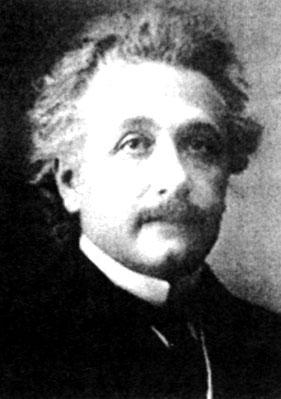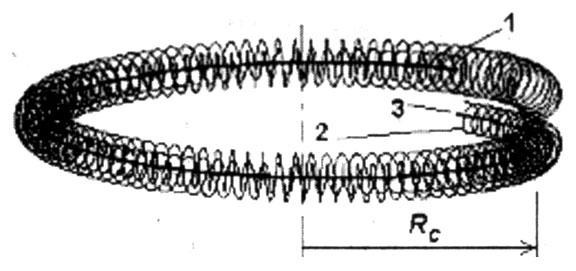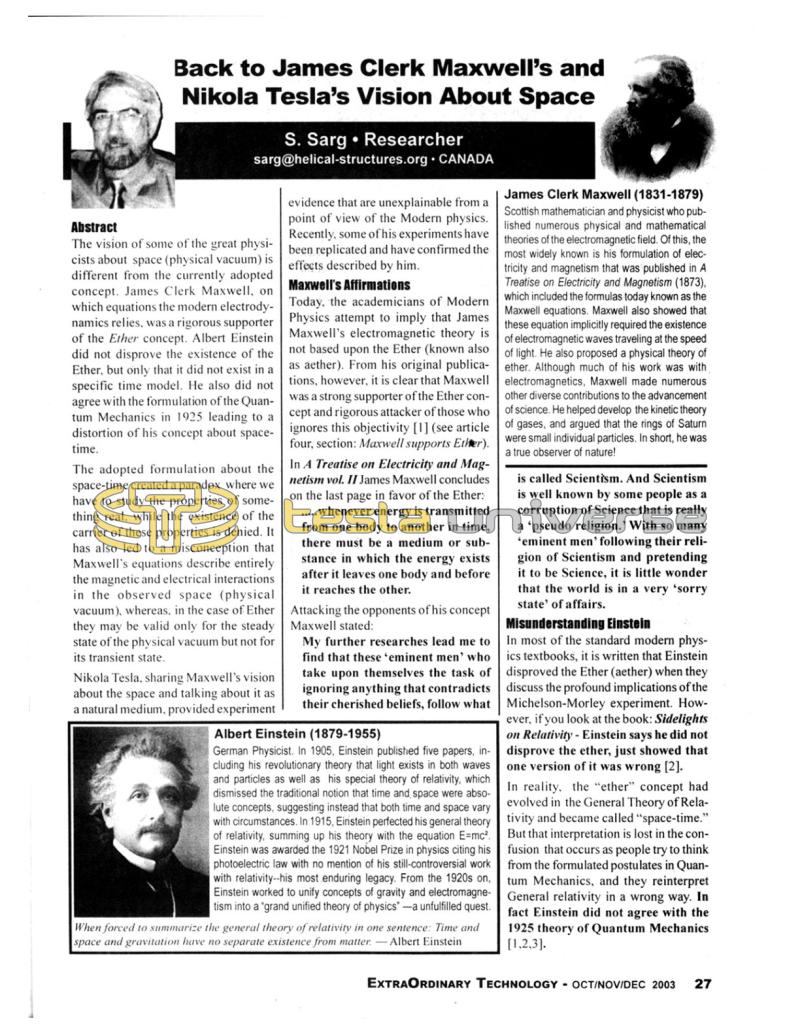
Nikola Tesla Articles
Back to James Clerk Maxwell's and Nikola Tesla's Vision About Space
Abstract
The vision of some of the great physicists about space (physical vacuum) is different from the currently adopted concept. James Clerk Maxwell, on which equations the modern electrodynamics relies, was a rigorous supporter of the Ether concept. Albert Einstein did not disprove the existence of the Ether, but only that it did not exist in a specific time model. He also did not agree with the formulation of the Quantum Mechanics in 1925 leading to a distortion of his concept about space-time.
The adopted formulation about the space-time created a paradox where we have to study the properties of something real, while the existence of the carrier of these properties is denied. It has also led to a misconception that Maxwell's equations describe entirely the magnetic and electrical interactions in the observed space (physical vacuum), whereas, in the case of Ether they may be valid only for the steady state of the physical vacuum but not for its transient state.
Nikola Tesla, sharing Maxwell's vision about the space and talking about it as a natural medium, provided experiment evidence that are unexplainable from a point of view of the Modern physics. Recently, some of his experiments have been replicated and have confirmed the effects described by him.
Albert Einstein (1879-1955)
German Physicist. In 1905, Einstein published five papers, including his revolutionary theory that light exists in both waves and particles as well as his special theory of relativity, which dismissed the traditional notion that time and space were absolute concepts, suggesting instead that both time and space vary with circumstances. In 1915, Einstein perfected his general theory of relativity, summing up his theory with the equation E=mc². Einstein was awarded the 1921 Nobel Prize in physics citing his photoelectric law with no mention of his still-controversial work with relativity -- his most enduring legacy. From the 1920s on, Einstein worked to unify concepts of gravity and electromagnetism into a "grand unified theory of physics" - a unfulfilled quest.
When forced to summarize the general theory of relativity in one sentence: Time and space and gravitation have no separate existence from matter. - Albert Einstein
Maxwell's Affirmations
Today, the academicians of Modern Physics attempt to imply that James Maxwell's electromagnetic theory is not based upon the Ether (known also as aether). From his original publications, however, it is clear that Maxwell was a strong supporter of the Ether concept and rigorous attacker of those who ignores this objectivity [1] (see article four, section: Maxwell supports Ether).
In A Treatise on Electricity and Magnetism vol. II James Maxwell concludes on the last page in favor of the Ether:
...whenever energy is transmitted from one body to another in time, there must be a medium or substance in which the energy exists after it leaves one body and before it reaches the other.
Attacking the opponents of his concept Maxwell stated:
My further researches lead me to find that these ‘eminent men' who take upon themselves the task of ignoring anything that contradicts their cherished beliefs, follow what is called Scientism. And Scientism is well known by some people as a corruption of Science that is really a ‘pseudo religion.' With so many ‘eminent men' following their religion of Scientism and pretending it to be Science, it is little wonder that the world is in a very ‘sorry state' of affairs.
James Clerk Maxwell (1831-1879)
Scottish mathematician and physicist who published numerous physical and mathematical theories of the electromagnetic field. Of this, the most widely known is his formulation of electricity and magnetism that was published in A Treatise on Electricity and Magnetism (1873), which included the formulas today known as the Maxwell equations. Maxwell also showed that these equation implicitly required the existence of electromagnetic waves traveling at the speed of light. He also proposed a physical theory of ether. Although much of his work was with electromagnetics, Maxwell made numerous other diverse contributions to the advancement of science. He helped develop the kinetic theory of gases, and argued that the rings of Saturn were small individual particles. In short, he was a true observer of nature!
Misunderstanding Einstein
In most of the standard modern physics textbooks, it is written that Einstein disproved the Ether (aether) when they discuss the profound implications of the Michelson-Morley experiment. However, if you look at the book: Sidelights on Relativity - Einstein says he did not disprove the ether, just showed that one version of it was wrong [2].
In reality, the "ether" concept had evolved in the General Theory of Relativity and became called "space-time." But that interpretation is lost in the confusion that occurs as people try to think from the formulated postulates in Quantum Mechanics, and they reinterpret General relativity in a wrong way. In fact Einstein did not agree with the 1925 theory of Quantum Mechanics [1,2,3].
A Perplexing Paradox
Today, physicists are taught that the ‘Ether' concept is nonsense, but in fact the natural media or "Ether" in Quantum Mechanics has been replaced by some of its attributes, such as: quantum fluctuations of the physical vacuum, vacuum polarization, zero-point energy, space-time metrics and other names [1]. As a result, theoretical physics is deprived of a critical element to solve the paradox it has created: studying the properties of the physical vacuum while ignoring the existence of the carrier of these properties.
The acceptance of the Ether's existence automatically leads to the conclusion that the physical vacuum should possess two kinds of features: a steady state and a transient state. Maxwell's belief about the existence of Ether is a riddle for the official physics community now. Could that be a delusion of the great physicist and mathematician? It becomes apparent now that it is not. In the time he lived (1831-1879), not enough experimental material for the transient state phenomena was available. Accordingly, he only provided equations describing the steady state of the Ether medium.
Some of the properties of this medium are now known as a space-time fabric or a physical vacuum. Current theoretical physics tries to explain all kinds of the observed phenomenon by relying on Maxwell's equations and adopted postulates from the beginning of 20th century. However, phenomena related with a transient state are outside of such formulated mathematical models. That's why some physical phenomena look like paradoxes.
In such an aspect, many academician physicists refuse to accept even obvious results of successful experiments, claiming that they contradict the laws of physics. The orthodox wing of modern physics oppose any revision of the formulation of the Quantum Mechanics in 1925, putting in such way a barrier that restricts the research of the transient phenomena. In a desire to provide explanations, without departure from the officially adopted concepts and relying only on a mathematical logic, some physicists propose nonrealistic abstractive theories such as a multidimensional space, a time reversal, worm holes, parallel universes, evaporation of black holes, overusage of the uncertainty principle and so on. This leads to a fallacy and ambiguity. In this aspect the article "The Greatest Math Error", by Dave Pressler, reported in international meeting and published in Journal of Theoretics appears quite useful [4]
Tesla's Empirical Evidence
One of the world's greatest discoverers, Nikola Tesla, undoubtedly could be considered as a pioneer researcher of the transient properties of the natural medium - the physical vacuum. Being closer to experiments rather than to the abstractive theories, he always referenced the space (a physical vacuum) as a Natural Medium. He unveiled experimentally some of the hidden properties of the space. His experiments, not understood by modern physics, are now labeled as "exotic".
Despite the fact that Nikola Tesla was the greatest inventor contributing to the industrial boom of the beginning of the 20th century, he considered himself more of a discoverer than an inventor. His discovery of Radiant Energy is a phenomenon belonging to the transient state of the space (physical vacuum). This discovery is so significant, that it could be compared with the electromagnetic induction discovered by Michael Faraday.
This kind of achievement and the theoretical vision of Nikola Tesla are dismissed by the contemporary modern physics today, because they do not match some of the postulates in the 1925 formulation of the Quantum Mechanics. That's why he did not obtain the credit he deserves from the physics community today.
Fig. 1. Structure of the electron comprised of three helical structures, one inside another, kept by superstrong forces. Two of the helical structures possess internal lattice (not shown). The axial symmetry in respect to the central core 3 allows oscillations of the internal two structures in conditions of ideal bearing. The geometrical parameters of the shown structure and its two proper frequencies of oscillations provide physical meanings for the well known physical parameters, such as: the electron spin, the Compton frequency, the gyromagnetic factor, the anomalous magnetic moment, the Rydberg constant and the energy sets of: 13.6 eV, 3.4 eV, 1.51 eV, 0.85 eV etc.
A few researchers have succeeded in replicating some of Tesla's experiments and have produced similar results. Presently, one may find more information about these types of experiments through Internet sources, than in the pages of officially supported journals. While skeptics prefer to close their eyes for such information, it is quite useful for open minded thinkers.
Successful Verification
A team of scientists from a Russian scientific institution (D. S. Strebkov et al) has rediscovered the method of the single wire energy transmission based on the Tesla discoveries 100 years ago. Their experimental results are published in two articles [5,6] in New Energy Technology magazine. The abstract of the article "Investigation of 20 kW, 6.8 kV, 80 mkm Single-Wire Electric Power System" [5] states:
20 kW, 6.8 kV, diameter 80 mkm (micron), 6 m long electric power transmission line was tested. There was demonstrated appearance of specific current density 600 A/mm2 and specific electric power density. 4 MW/mm2 without overheating of copper single-wire line of 80 mkm diameter.
In the text description of the second paper [6] by the same authors, "New Results of Development and Testing of Single-Wire Electric Power System", it is written:
The equipment comprised Tesla transformers, which were connected to the line with two resonant circuits, and adjusted to the resonant frequency f0, where l00Hz<f0<100kHz. Placed in the beginning of a line the resonant circuit consists of the primary winding, the step-up high frequency Tesla transformer and condensers battery, which were connected in parallel to the primary winding. The parallel resonant circuit was connected to the static frequency converter. As a load there were used 24 filament lamps (220 V, 1 kW) that were arranged in 12 parallel groups, each consisted of 2 connected in series lamps. The lamps were connected to a step-down Tesla transformer through a 400 V/25 kW bridge rectifier.
Based on provided experiments the Russian team claims that a technology is developed allowing them to obtain six patents. For prior art, only Tesla's patent on the "Apparatus for transmission of electrical energy" [7] is cited.
A Sad State of Affairs
It is a sad fact that the official peer review journals currently do not accept open discussion about such an important topic as the space-time fabrics (physical vacuum). Any attempt to challenge the status quo is usually marked as "speculation". In the time of Internet, however, dissemination of scientific information does not obey artificially created boundaries. Independent peer review journals have already formed and quite successfully serve the international scientific community with credible information. The list of such journals or data bases include the Journal of Theoretics [8], the New Energy Technologies magazine [9], and the large database of the Institute of New Energy [10], as well as a large number of other sources.
Presently, some experiments, related to zero point vacuum energy, are provided by independent private organizations and researchers. Without a credible physical theory, the experimenters usually work in darkness following their own intuition. In such an approach, successful results are very rare. But even with a successful experiment, the skeptics claim that the results contradict the laws of Physics. Then, what rules are more important, those provided by the present physical knowledge or those established by the Nature?
Basic Structures of Matter
The newly developed unified theory. Basic Structures of Matter [11,12], is based on an alternative vacuum concept, and agrees in full with Maxwell's and Tesla's vision about the space. It suggests, quite successfully, an original model of the underlying structure of the physical vacuum giving a fundamental basis for analysis of physical phenomena in both states of the space, the steady state and the transient state.
Obtaining of energy from vacuum is confirmed from a number of experiments. Many experimentalists or theoreticians have tried to explain this phenomenon in a way not contradicting the known laws of physics, but not quite successfully in order to resist the critics. They either contradict some physical law or build super abstractive theories without any useful practical output. The problem is that they rely on in the presently adopted concept about space (physical vacuum), which doesn't correspond to the reality. (Tesla always speaks about space as a natural medium). This problem is avoided in the BSM theory.
According to the Basic Structure of Matter (BSM) theory, the space in which we are immersed contains an underlying grid structure called Cosmic Lattice (CL) (an unexplored Ether model). The elementary particles also contain structure. Both, the space structure and the elementary particles contain common building blocks - two types of sub-elementary particles.
The basic element of the space structure is an oscillating CL node. Such space contains two types of zero point energy wells: a weaker one - from the CL nodes oscillations denoted as AC ZPE (kinematic) and a stronger one from the CL nodes interconnections denoted as DC ZPE (static). In relation to contemporary physics, the AC ZPE energy is only apparent (related to the EM fields), while the strongest DC ZPE is obscured.
It was found, according to the BSM analysis, that the AC ZPE is associated to the experimentally determined cosmic microwave background temperature of 2.72K, so it is constant. When the electron is moving in CL space due to applied EM field, the external helical structure 1 is screwing in the space (but the tangential velocity is always below the speed of light), while the structures 2 and 3 oscillate and interact with the oscillating CL nodes. The proper oscillation frequency between structures 1 and 2 is the well-known Compton frequency v=1.2356x1020Hz, while the radius Rc=2!$ \pi !$c/v is the Compton radius of the electron.
When an electron plasma (preferably in a low pressure conditions in order to reduce the collision effect) is excited by a high frequency and high voltage EM field, the conditions of the interactions between the accelerated (and oscillating) electron and the oscillating CL nodes change. From a point of view of BSM, a specific mechanism takes place (not described here) and it could be connected to the observed effect of radiant energy, experimentally discovered by Nikola Tesla. It is theoretically envisioned, from BSM point of view, that in proper experimental conditions some over-unity effect may occur.
This means than a small fraction of the DC ZPE could be transferred to AC ZPE, while the latter (kept automatically constant) must transfer this energy as EM waves, which could be captured by a properly tuned LC circuit. The CL space in which we live and observe is interconnected to the Universe, so the DC ZPE is unlimited. In such aspect there is not any violation of the energy conservation law. The presented concept is in a full agreement with the Nikola Tesla prophetic statement "Through the space there is energy".
References and links:
- http://www. einsteinconspiracv.co.uk/ (about the distortion of the original vision and ideas of some of greatest physicists in order to match the current vision of the Modern physics today)
- Albert Einstein, Sidelights on Relativity
- A. Einstein, B. Podolsky and N. Rosen, Can Quantum-mechanical Description of Physical Reality Be Considered Complete?, Physical Review, v. 47, 777-780 (1935)
- D. Pressler, Greatest Math Error, Journal of Theoretics, vol. 5-1, (2003) (Extracted from a lecture at 12th Midwest Relativity Meeting at Chicago University in 2002).
- D. S. Strebkov, S. V. Avramenko, A. I. Nekrasov, O. A. Roschin, Investigation of 20 kW, 6.8kV, 80 mkm Single-Wire Electrical Power System, New Energy technology, #6, 52-54, (2002) www.faraday.ru/net.htm
- D. S. Strebkov, S. V. Avramenko, A. I. Nekrasov, O. A. Roschin, New Results of Development and Testing of Single-wire Electric Power System, New Energy technology, #5, 17-19, (2002) www.faraday.ru/net.htm
- Nikola Tesla, Apparatus for transmission of electrical energy, US Patent 649621 15.05.1900. www.keelynet.com/tesla/
- Journal of Theoretics (on-line peer reviewed) www.journaloftheoretics.com
- New Energy technologies magazine www.faraday.ru/net.htm
- Institute of New Energy (large data base) www.padrak.com/ine/index.shtml
- S. Sarg, Basic Structures of Matter, 2001 www.helical-structures.org
- S. Sarg, Brief Introduction to the Basic Structures of Matter Theory and Derived Atomic Models, Journal of Theoretics, Jan 2003 www.journaloftheoretics.com/Links/Papers/Sarg.pdf


